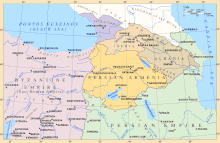Roman invasion

Martin was the newly-appointed Master of Soldiers in the East ( magister militum per Orientem ) at the time, but according to primary sources did not have much authority over other generals. The Roman invasion force, which numbered 30,000 in total, was initially scattered:
- Martin and his forces, stationed in Citharizum with Ildeger and Theoctistus
- Peter and Adolius and their forces
- Valerian, the magister militum per Armeniam , stationed near Theodosiopolis; joined by Narses (a Persarmenian) [5] and his regiment of Heruls (under Philemouth and Verus) and Armenians
Justus, Peranius, Domnentiolus, John, son of Nicetas, and John the Glutton stayed at Phison, near Martyropolis. They raided Taraunitis (Taron) and then retreated. [4] [6]
The target of the offensive was Dvin, the capital of Sasanian Armenia. The city was an important commercial center in the region, and it had ample supplies and was suitable for cavalry action. Besides, it was the place where the Christian envoys came from who were likely to switch to the Roman side. According to Syvänne, the Catholicos and his brother may have planned the operation together with Valerian. [7]
Persian forces in Persarmenia numbered 4,000 and were under the command of Nabedes. They concentrated at the mountainous village of Anglon about 13 miles (21 km) from Dvin [8] (probably identical to Ankes/Angegh/Angel, Dsakhgodn Canton, Ayrarat Province, Kingdom of Armenia) [9] [10] [11] [12] The Anglon village featured a namesake fortress perched on top of the precipitous mountain and surrounded by village houses which crowded in a narrow space. Nabedes prepared a defensive position for an elaborate ambush by blocking the entrances to the village with stones and carts, digging "a sort of trench", and setting up ambushes in the houses of the village outside the fortress, while marshaling an army below. Some were stationed in the fortress itself, constituting the last element of the ambush. [13]
The Roman forces united only after crossing the Persian border, in the plain of Dvin. It probably numbered more than 20,000. Peter advanced first, probably as a vanguard. [7] The Romans had been marching in strict formations, but as soon as they found out that the Persians are concentrated in Anglon, they spread out to plunder. [13] According to Procopius, the Roman generals lacked a proper union among themselves (cf. #Analysis ). One day's march from Anglon, a captured Persian spy told the Romans that Nabedes has fled. As the Roman forces proceeded into the rough terrain of Anglon, they probably assumed that Persians are hiding in the fortifications. Soon Roman scouts informed their commanders of the presence of a Persian army in the open. Upon receiving this news, the Roman army hastily formed a single-line formation. Martin's forces formed the center, Peter's forces formed the right, and Valerian's forces (probably joined by Narses and his Heruls and Armenians) formed the left. The formation was imperfect due to roughness of the terrain and the fact that it was formed on the spur of the moment. The Persians were arranged in a small space. Nabedes had ordered them not to begin fighting unless after being attacked. [4] [14] [15] [16] [13] [7]
Narses and his regulars and Heruls were the first to engage the Persians in close combat. Apparently, part of the Persian army was defeated, and the Persian cavalry retreated (or feigned retreat) toward the fortress via a narrow way. Their flight was followed by Narses and his men as koursores . The rest of the Romans joined, too. As the pursuing Romans passed through the narrow streets and rough terrain of the village under the fort, the Persians (presumably dismounted cavalrymen) launched their ambush from the village buildings outside the fortress, attacking the Heruls and killing their commander Narses in close combat. Other Roman cavalrymen that had followed Narses' forces were now trapped in the rough terrain in narrow alleys. Nabedes ordered a general counter-attack that included a sortie of the Persians who sallied out from the fortress and shot against the masses of the Romans, especially the lightly-armored Heruls in the open area and other Romans that were trapped in narrow alleys. The Romans and their commanders panicked and fled, leaving their heavy equipment (including arms, armor, draft animals, and baggage train) behind. The Persians did not pursue them beyond the rough terrain out of fear of an ambush by the much larger Romans, but the Romans continued to flee from the region. Adolius was among those killed in the retreat. [4] [14] [15] [16] [13] [7]

